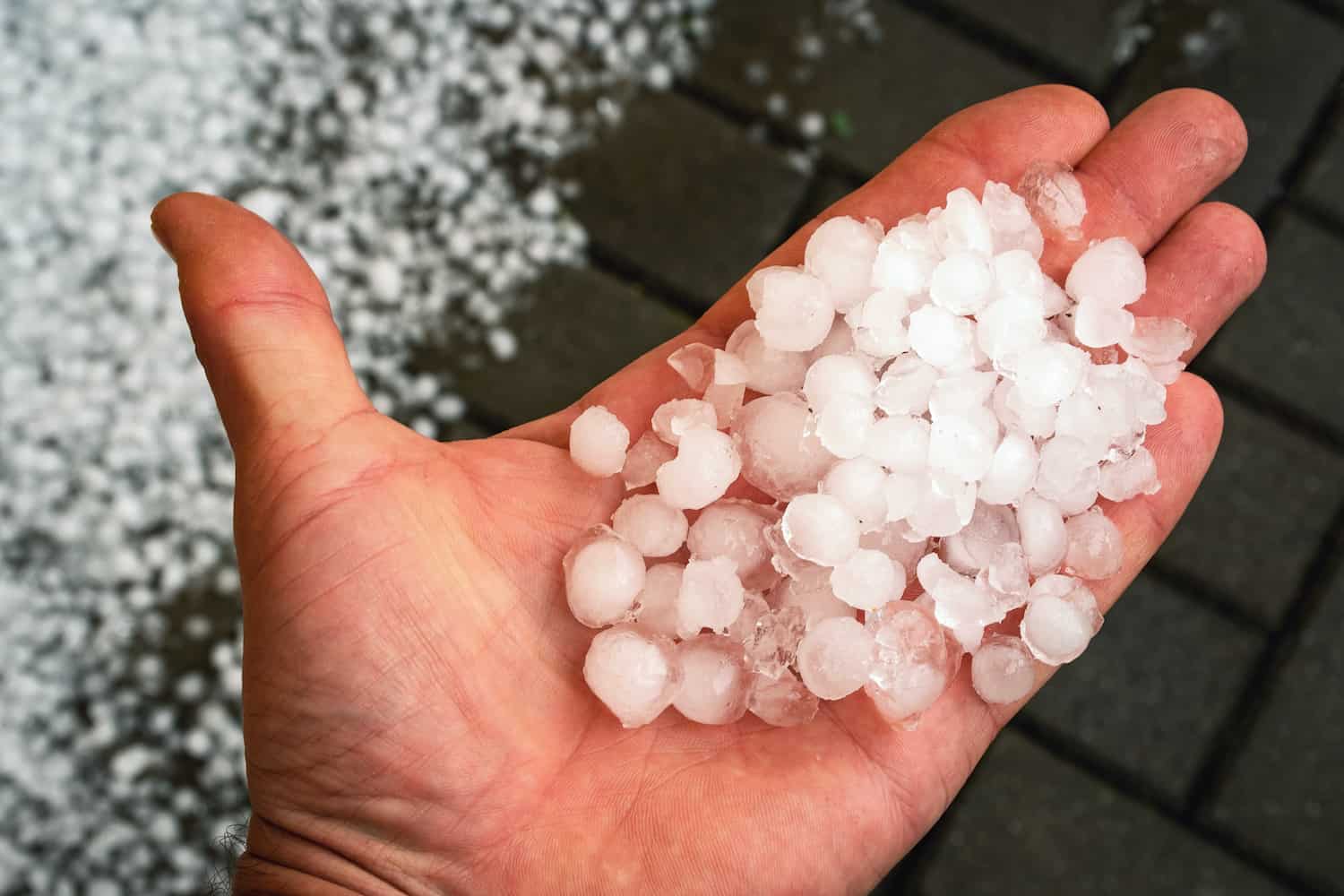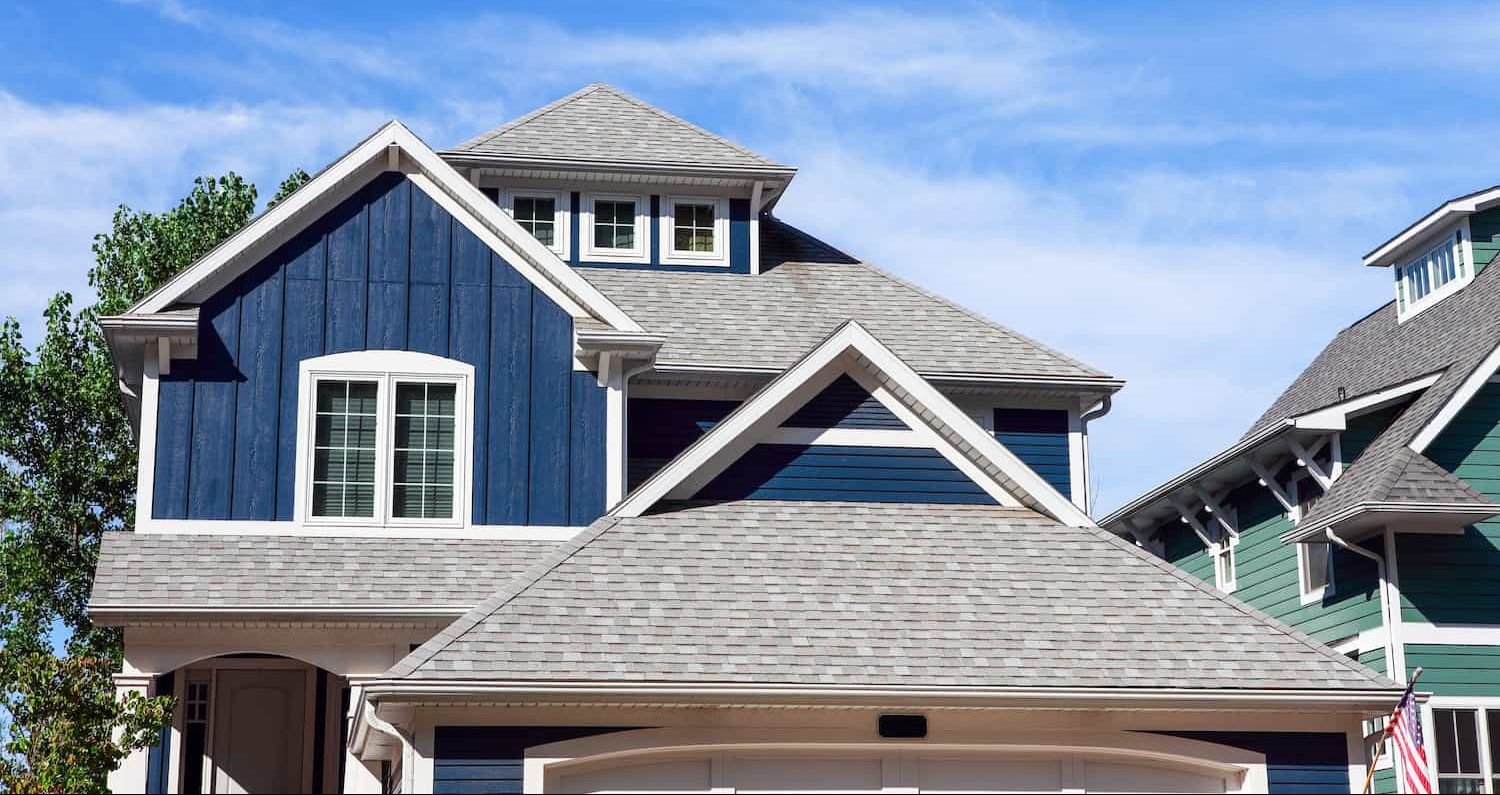Hail storms can be rare, especially compared to common rain storms. You probably find yourself gathering around the windows with your kids and pointing out the loud hail when it happens.
Hail storms can pass quickly, but unfortunately, they can also leave lasting damage on your car, siding, and roof. After a hail storm, you need to keep your eyes peeled for signs of storm damage, and better yet, contact a professional roofing contractor to inspect your roof.
What does hail damage look like on a roof? Take a look at the picture examples below!
What Can Roof Hail Damage Look Like?
Some signs of hail damage are very unique and specific, while others are indicative of many different kinds of storm damage. Some of these common signs of hail damage are visible from the ground, while others require a professional roofer to take a closer look.
- Dents or impact marks
- Bald spots & missing granules
- Cracked shingles
- Broken shingles
1) Dents or Impact Marks

The impact of hailstones can form dents on your roof. You may also notice dents on your car, on top of your air conditioner, or on other structures outside.
Impact marks or dents not only cause cosmetic issues that impact your curb appeal and resale value, but they can also cause your roof to lose its protective qualities.
2) Bald Spots & Missing Granules

Bald spots and missing granules tie in very closely with dents. If you look closely at a dent, you’ll notice that the first layer of shingle granules has been scraped off.
Shingle granules are the first layer of protection on your roof. If they start to wear off, it leaves your roof vulnerable to more damage.
3) Cracked Shingles

Just like a cracked dinner plate, hail can cause your asphalt shingles to crack. Cracks are an issue because they can allow water to seep into the underlayers of your roof and eventually into your home.
Interior water damage can take a while to appear to the naked eye inside your home. By the time you’ve noticed a water stain or musty smells, water leaking from your roof has already caused expensive damage. That’s why it’s vital to have your roof inspected after a hail storm— so your roofing contractor can look for cracks in your shingles.
4) Broken Shingles

Intense hail storms (or even smaller hailstones hitting an older roof) can go a step beyond shingle cracks and actually completely break or fracture your shingles.
This type of hail damage isn’t as common, but if you or your roofing contractor notice it, you need to act fast. Have your roofer tarp your roof so that water can’t seep into your home if it rains again. Then, schedule the appropriate repairs or roof replacement as soon as possible.
What Impacts the Extent of Hail Damage?
Not every hail storm will result in roof damage, but there are some factors that can increase the likelihood of sustaining damage. Hail size, hail shape, and wind speed all have major effects on the extent of damage you might receive.
Hail Size 📏
It’s a common misconception that hail needs to be very large to cause any damage. However, hailstones range in size from pea-sized to softball-sized. While a storm with softball-sized hail will definitely cause more immediate, obvious damage, don’t write off the pea-sized hail.
Even small pieces of hail can cause dents and granule loss. Be sure to schedule a professional roofing inspection after any hailstorm.
Hail Shape 🧊
Some hailstones are crystalized, with sharp, jagged edges. If you’re unlucky enough to experience a hailstorm with crystalized hail, your roof is at a much higher risk of cracked shingles.
Wind Speed 🌬️
The only thing worse for your roof than a hailstorm is a hailstorm with heavy winds. For hailstones between two and four inches, the speed of their impact is usually between 44 and 72 miles per hour!
The speed and direction of wind paired with the size and shape of the hailstone is the formula that influences how much or little hail damage you sustain.
What to Do If You Sustain Roof Hail Damage
Thankfully, you may not have to pay for roof repairs or a replacement entirely out of your own pocket if you get roof damage. Your homeowners insurance policy is in place for this exact circumstance. If you schedule a roof inspection with a professional roofer and they confirm the presence of hail damage, you should follow these steps:
- Document the roof damage with photos, notes, and dates.
- Reference your insurance policy to see what is and isn’t covered. Usually, hail damage is covered under a standard homeowners insurance policy, but be sure to confirm before you proceed.
- Contact your insurance company to file a claim. Be sure to utilize the photos and other documentation you have.
- Schedule a time for an insurance adjuster to inspect your roof.
- If your claim is approved, schedule repairs or a replacement with your preferred local roofing company. Even if your claim doesn’t get approved, you should still move forward with any repairs your roofing contractor suggests.
- If approved, you’ll pay your deductible and receive a check in the mail for the approved costs.
Give Gouge a Call After Hail Storms
Hail damage on your roof can be sneaky— so don’t assume nothing is wrong if you can’t see obvious signs of damage from the ground. Be sure to call a reputable local roofing company like Gouge Quality Roofing after any major storm. We’ll promptly inspect your roof, looking for signs of damage.
If we spot damage, we’ll repair it quickly— whether or not you decide to file an insurance claim. Contact us today for your free inspection!






